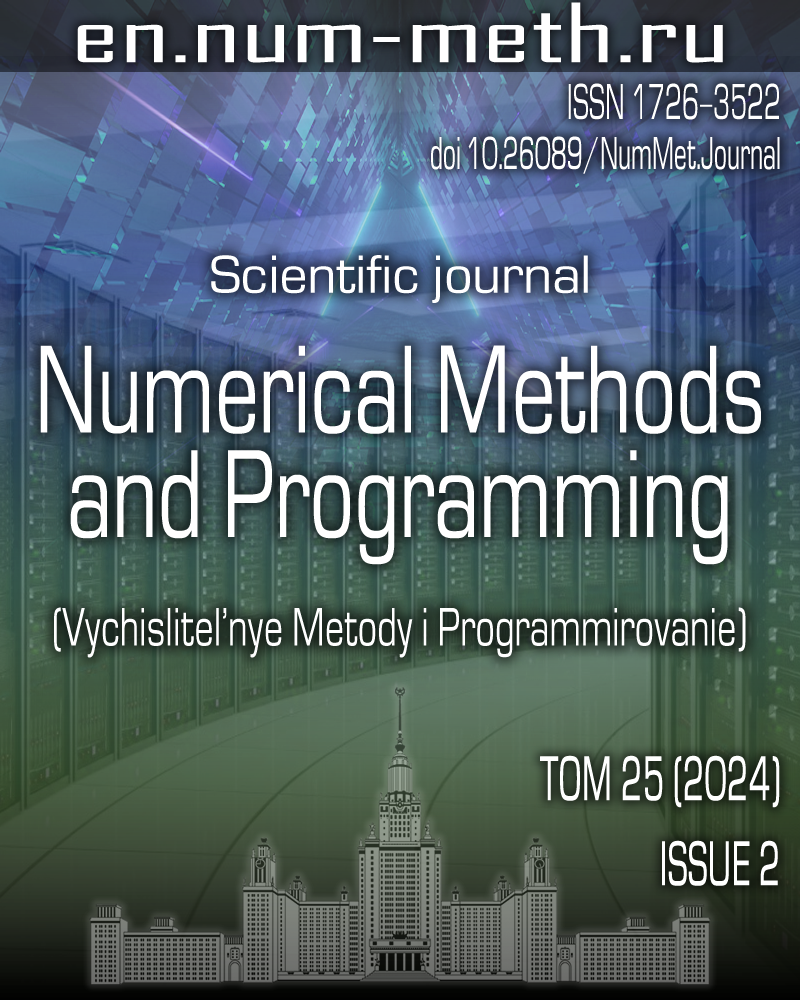DOI: https://doi.org/10.26089/NumMet.v25r215
Acceleration of parallel solution of 2D boundary value problems with two-grid preconditioning
Keywords:
boundary value problems
quasi-structured grids
two-grid preconditioning
parallelization
solution acceleration
Abstract
An algorithm for accelerating the solution of boundary value problems on quasi-structured grids is proposed and experimentally studied. The basis of the algorithm is two-grid preconditioning, which is built on a macro-grid, which is an element of a quasi-structured grid. This approach does not require the introduction of additional tools. A series of numerical experiments were carried out, the results of which show acceleration of calculations by 2.5 times without parallelization only due to preconditioning without parallelization and demonstrate super-acceleration during parallelization.
Published
2024-05-04
Issue
Section
Methods and algorithms of computational mathematics and their applications
References
- A. N. Kozyrev and V. M. Sveshnikov, “On the Construction of Two-Dimensional Local-Modified Quasistructured Grids and Solving on Them Two-Dimensional Boundary Value Problem in the Domains with Curvilinear Boundary,” Vestn. Yuzhn. Ural. Gos. Univ. Ser. Vychisl. Mat. Inf. 6 (2), 5-21 (2017).
- V. D. Liseikin, Grid Generation Methods (Springer, Berlin, 1999).
- Yu. I. Shokin, N. T. Danaev, G. S. Khakimzyanov, and N. Yu. Shokina, Lectures on Difference Schemes on Moving Grids (KazNU, Almaty, 2008), Part 2 [in Russian].
- A. A. Samarskii, The Theory of Difference Schemes (Nauka, Moscow, 1989; CRC Press, Boca Raton, 2001).
doi 10.1201/9780203908518 - O. V. Ushakova, “On the Development of the Variational Approach to the Generation of Optimal Grids (A Review),” Tr. Inst. Mat. Mekh. UrO RAN 29 (2), 217-247 (2023).
doi 10.21538/0134-4889-2023-29-2-217-247 - R. P. Fedorenko, “The Speed of Convergence of One Iterative Process,” Zh. Vichisl. Mat. Mat. Fiz. 4 (3), 559-564 (1964). [USSR Comput. Math. Math. Phys. 4 (3), 227-235 (1964)].
doi 10.1016/0041-5553(64)90253-8 - N. S. Bakhvalov, “On the Convergence of a Relaxation Method with Natural Constraints on the Elliptic Operator,” Zh. Vichisl. Mat. Mat. Fiz. 6 (5), 861-885 (1966). [USSR Comput. Math. Math. Phys. 6 (5), 101-135 (1966)].
doi 10.1016/0041-5553(66)90118-2 - A. Brandt, “Multi-Level Adaptive Solutions to Boundary-Value Problems,” Math. Comp. 31 (138), 333-390 (1977).
- W. Hackbusch, Multi-Grid Methods and Applications (Springer, Berlin, 1985).
- Yu. V. Vasilevsky and M. A. Olshansky, A Short Course on Multigrid and Domain Decomposition Methods (Mosk. Gos. Univ., Moscow, 2007) [in Russian].
- Y. Saad, Iterative Methods for Sparse Linear Systems (SIAM Press, Philadelphia, 2003; Mosk. Gos. Univ., Moscow, 2013).
- R. Bank, R. Falgout, T. Jones, et al., “Algebraic Multigrid Domain and Range Decomposition (AMG-DD/AMG-RD),” SIAM J. Sci. Comput. 37 (5), S113-S136 (2015).
doi 10.1137/140974717 - A. Napov and Y. Notay, “An Efficient Multigrid Method for Graph Laplacian Systems II: Robust Aggregation,” SIAM J. Sci. Comput. 39 (5), S379-S403 (2017).
doi 10.1137/16M1071420 - S. K. Godunov, Equations of Mathematical Physics (Nauka, Moscow, 1979) [in Russian].
- A. M. Matsokin and S. V. Nepomnyashchikh, “The Schwarz Alternation Method in a Subspace,” Izv. Vyssh. Uchebn. Zaved. Mat. No. 10, 61-66 (1985). [Soviet Math. (Iz. VUZ). 29 (10), 78-84 (1985)].
- V. Dolean, P. Jolivet, and F. Nataf, An Introduction to Domain Decomposition Methods: Algorithms, Theory, and Parallel Implementation (SIAM Press, Philadelphia, 2015).
doi 10.1137/1.9781611974065.fm - A. Quarteroni and A. Valli, Domain Decomposition Methods for Partial Differential Equations (Oxford Univ. Press, Oxford, 1999).
- H. Xiang and F. Notaf, “Two-Level Algebraic Domain Decomposition Preconditioners Using Jacobi-Schwarz Smoother and Adaptive Coarse Grid Corrections,” J. Comput. Appl. Math. 261 (1), 1-13 (2014).
doi 10.1016/j.cam.2013.10.027 - Y. Saad and M. H. Schultz, “GMRES: A Generalized Minimal Residual Algorithm for Solving Nonsymmetric Linear Systems,” SIAM J. Sci. Stat. Comput. 7 (3), 856-869 (1986).
doi 10.1137/0907058 - V. P. Ilyin, Finite Difference and Finite Volume Methods for Elliptic Equations (Inst. Comput. Math. Math. Geophys., Novosibirsk, 2000) [in Russian].
- V. M. Sveshnikov, “Construction of Direct and Iterative Decomposition Methods,” Sib. Zh. Ind. Mat. 12 (3), 99-109 (2009). [J. Appl. Ind. Math. 4 (3), 431-440 (2010)].
doi 10.1134/S1990478910030166 - V. A. Syrovoy, V. M. Sveshnikov, and A. N. Kozyrev, Analytical and Numerical Modeling of Intense Beams of Charged Particles (Inst. Comput. Math. Math. Geophys., Novosibirsk, 2023) [in Russian].
- A. N. Kozyrev and V. M. Sveshnikov, “An Experimental Study of the Efficiency of Solving 2D Boundary Value Problems on Subgrids of Quasi-Structured Rectangular Grids,” Sib. Zh. Vych. Mat. 24 (3), 277-288 (2021). [Numer. Anal. Appl. 14 (3), 238-248 (2021).
doi 10.1134/S1995423921030046] - G. I. Marchuk, Methods of Computational Mathematics (Nauka, Moscow, 1980; Springer, New York, 1982).
License
Copyright (c) 2024 А. Н. Kозырев, В. Д. Корнеев, В. М. Свешников

This work is licensed under a Creative Commons Attribution 4.0 International License.


